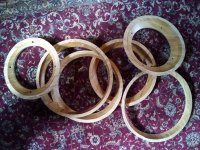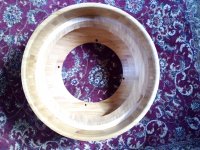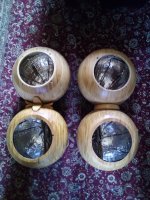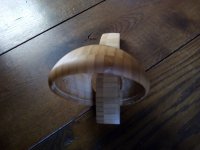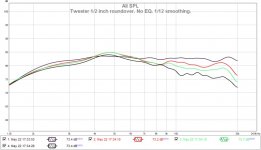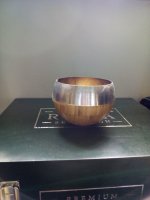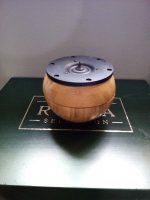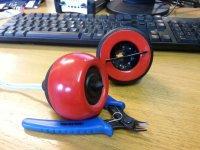Bracing. Not so easy with spheres. Of course they are already very strong, but I am a belt and braces man so I wanted to brace them well.
So I bought four extra bamboo bowls, cut them into rings and hey presto perfect bracing!
I am gluing them in under pressure with the grain running in the opposite direction to maximise strength and rigidity.
So I bought four extra bamboo bowls, cut them into rings and hey presto perfect bracing!
I am gluing them in under pressure with the grain running in the opposite direction to maximise strength and rigidity.
Attachments
It'd be a bit trickier, but I would try to make an eyeglass frame (shape of an 8) type mount so the two enclosures could be rotated to point whatever direction you want. If that doesn't work then what you've got there looks like it should work.
That's a great idea for bracing!
That's a great idea for bracing!
Your project looks great! I am thinking about doing a project with those Ikea bowls and was wondering how you cut the holes for the drivers? Did you just use a router with a circle jig or did you use something else? Thanks!
Your project looks great! I am thinking about doing a project with those Ikea bowls and was wondering how you cut the holes for the drivers? Did you just use a router with a circle jig or did you use something else? Thanks!
"I then had the issue of rear mounting the VM752 into the dome shape. After trying a few different approaches (and scrapping a few bowls), I settled on using a very large hole saw, then a table sander to achieve a near perfect fit."
It'd be a bit trickier, but I would try to make an eyeglass frame (shape of an 8) type mount so the two enclosures could be rotated to point whatever direction you want.
Thanks for the suggestion. I thought about it, but think it will make the whole speaker quite a bit bulkier and I am keen to keep it as close to the two spheres as possible.
With this in mind what do people think looks better? The ring connector or the x shape connector?
Attachments
Your enclosure to control the diffraction effects on the tweeter is about the worst possible choice. It effectively will be seen by the tweeter as a cylinder with tweeter mounted in the circular face. This was demonstrated in the fundamental results of Harry Olson, Figs 2c, 18 ofThe Scanspeak 7000 tweeter is then mounted into a small bamboo bowl to allow a decent round-over and attempt to minimise diffraction.
http://www.aes.org/aeshc/pdf/how.the.aes.began/olson_direct-radiator-loudspeaker-enclosures.pdf
The round-over radius needs to be much larger at higher frequencies. Actually the original Wilmslow design shows a good understanding of effective diffraction control at treble frequencies, as it approximates one of the best shapes of the Olson studies (Fig 17).
The shape of the enclosure becomes relatively unimportant for diffraction at low frequencies, so there is no real advantage for a sphere at bass frequencies. On the other hand the sphere does have an advantage for force cancelling opposed drivers at sub-woofer frequencies. This requires a rigid sphere though, as B&W use.
Another issue is that the mid and bass enclosures will also cause diffraction effects to the treble. The whole enclosure has to be designed to control the diffraction effects which are more pronounced at higher frequencies.
Thanks for your observations Bon. I am of course well aware of them. I was also concerned about having the tweeter centrally mounted in what is essentially a circular baffle, therefore I routed a 1/2 inch roundover into it.
Intended crossover is 3500hz so this may be enough, if not, I have another enclosure made up from a larger bowl with an even greater radius. Measurements will be done before settling on one.
The mid-dome enclosure will obviously go up to 3500hz so the spherical shape is very useful. You are correct -they will interact like all enclosures and baffle shapes do, but in my experience the spherical enclosure has the least audible affect I find sharp edges 'give themselves away'.
The bass enclosure does not need to be spherical for diffraction reasons (wavelengths are too long) but also in my personal experience, you cannot achieve the complete inertness of a sphere with a flat sided box type enclosure. There are no corners, no edges and only a single surface so vibrational modes are not propagated/encouraged. This is the main reason (besides aesthetic) to make it spherical too.
So spheres it is for all three separate enclosures for different reasons. I have made many speakers over the years and even my very heavily braced birch plywood, cld baffled, ones have not been as completely devoid of vibration as my spherical ones.
So I think reasonable arguments to have a go with spheres being mindful that measurements will be the final judge, but the nice thing is that I still have the original enclosures so if it all goes wrong, I can simply revert back!
Have you ever tried spherical enclosures? You might be surprised! 😉
Intended crossover is 3500hz so this may be enough, if not, I have another enclosure made up from a larger bowl with an even greater radius. Measurements will be done before settling on one.
The mid-dome enclosure will obviously go up to 3500hz so the spherical shape is very useful. You are correct -they will interact like all enclosures and baffle shapes do, but in my experience the spherical enclosure has the least audible affect I find sharp edges 'give themselves away'.
The bass enclosure does not need to be spherical for diffraction reasons (wavelengths are too long) but also in my personal experience, you cannot achieve the complete inertness of a sphere with a flat sided box type enclosure. There are no corners, no edges and only a single surface so vibrational modes are not propagated/encouraged. This is the main reason (besides aesthetic) to make it spherical too.
So spheres it is for all three separate enclosures for different reasons. I have made many speakers over the years and even my very heavily braced birch plywood, cld baffled, ones have not been as completely devoid of vibration as my spherical ones.
So I think reasonable arguments to have a go with spheres being mindful that measurements will be the final judge, but the nice thing is that I still have the original enclosures so if it all goes wrong, I can simply revert back!
Have you ever tried spherical enclosures? You might be surprised! 😉
Attachments
Last edited:
Bon's comments got me thinking before I make a second tweeter enclosure like the first, and given I have three different prototypes at present, I should take some measurements.
Initial measurements of the tweeter in the above enclosure with a 1/2 inch round-over transitioning into a larger radius hemisphere are better than I hoped, and I think I will be able to get away without having to use one of the larger, less 'aesthetically pleasing' bowls.
However these measurements are taken with the tweeter enclosure supported on cushions, so isn't completely accurate as it needs to be measured whilst mounted on the mid-dome sphere of course.
I am still hopeful that they will remain fairly good though. I will mock them up on the mid-dome spheres with some double sided tape when I get a moment.
Initial measurements of the tweeter in the above enclosure with a 1/2 inch round-over transitioning into a larger radius hemisphere are better than I hoped, and I think I will be able to get away without having to use one of the larger, less 'aesthetically pleasing' bowls.
However these measurements are taken with the tweeter enclosure supported on cushions, so isn't completely accurate as it needs to be measured whilst mounted on the mid-dome sphere of course.
I am still hopeful that they will remain fairly good though. I will mock them up on the mid-dome spheres with some double sided tape when I get a moment.
Attachments
Some of the various tweeter enclosure prototypes more in the garage!
The metal one was a nightmare to cut so I decided it was a no go. The other one would behave more like a cylinder with the sharp edge of the tweeter faceplate being exposed - I believe this is more the kind of situation Bon was referring to - a sharp defracting edge at a consistent distance from the point source.
Of course diffraction is an interesting thing - it has to happen - edge treatments, enclosure shape and baffle geometry only determine how the diffraction transition occurs - which is why a sphere smooths it out to look like a baffle step transition (at long enough wavelengths all enclosures approximate a sphere!), whilst a sharp edge puts the diffraction ripple into a concentrated region and is therefore of higher amplitude.
This is why I don't like asymmetrical driver placement on baffles - it means the polar response is different on the left than to the right. This tonal asymmetry seems inelegant to me if you are trying to get a nice uniform power response.
The metal one was a nightmare to cut so I decided it was a no go. The other one would behave more like a cylinder with the sharp edge of the tweeter faceplate being exposed - I believe this is more the kind of situation Bon was referring to - a sharp defracting edge at a consistent distance from the point source.
Of course diffraction is an interesting thing - it has to happen - edge treatments, enclosure shape and baffle geometry only determine how the diffraction transition occurs - which is why a sphere smooths it out to look like a baffle step transition (at long enough wavelengths all enclosures approximate a sphere!), whilst a sharp edge puts the diffraction ripple into a concentrated region and is therefore of higher amplitude.
This is why I don't like asymmetrical driver placement on baffles - it means the polar response is different on the left than to the right. This tonal asymmetry seems inelegant to me if you are trying to get a nice uniform power response.
Attachments
Last edited:
On the other hand the sphere does have an advantage for force cancelling opposed drivers at sub-woofer frequencies. This requires a rigid sphere though, as B&W use.
Just noticed this in your post - perhaps you haven't had a chance to read the thread right through - but this is exactly what I am planning with a schedule 80 12" PVC pipe and four subwoofers.
The 'bass sphere' will only reach down to 80-90 Hz, so I am planning two stereo push-push force cancellation sub-woofers exactly as you propose. 😀😀😀
Attachments
The ring is much cleaner.With this in mind what do people think looks better? The ring connector or the x shape connector?
Are those tweeter measurements in 15-degree steps?
The ring is much cleaner.
Are those tweeter measurements in 15-degree steps?
Probably more like 10 degrees - but very 'Ish'!
It is a quick and dirty measurement after getting myself worried that the diffraction would be as hideous as a cylinder. Fortunately it is actually better than on the Prestige cabinet.
Interestingly it appears to beam less as well - but this really needs to be confirmed with properly controlled measurements. I guess it makes sense as I have almost removed the baffle entirely.
It will be interesting to see if sitting the 'pod' on the larger sphere will wreak the measurements....I think not, but we will see.
Last edited:
I used 3D printing to make some pods for my doors in the past,

Mounted in my door:

A friend on the DIYMA forum liked what I had done so I ended up designing a (two part) free standing pod for him.

Here's the printed (and painted) result:
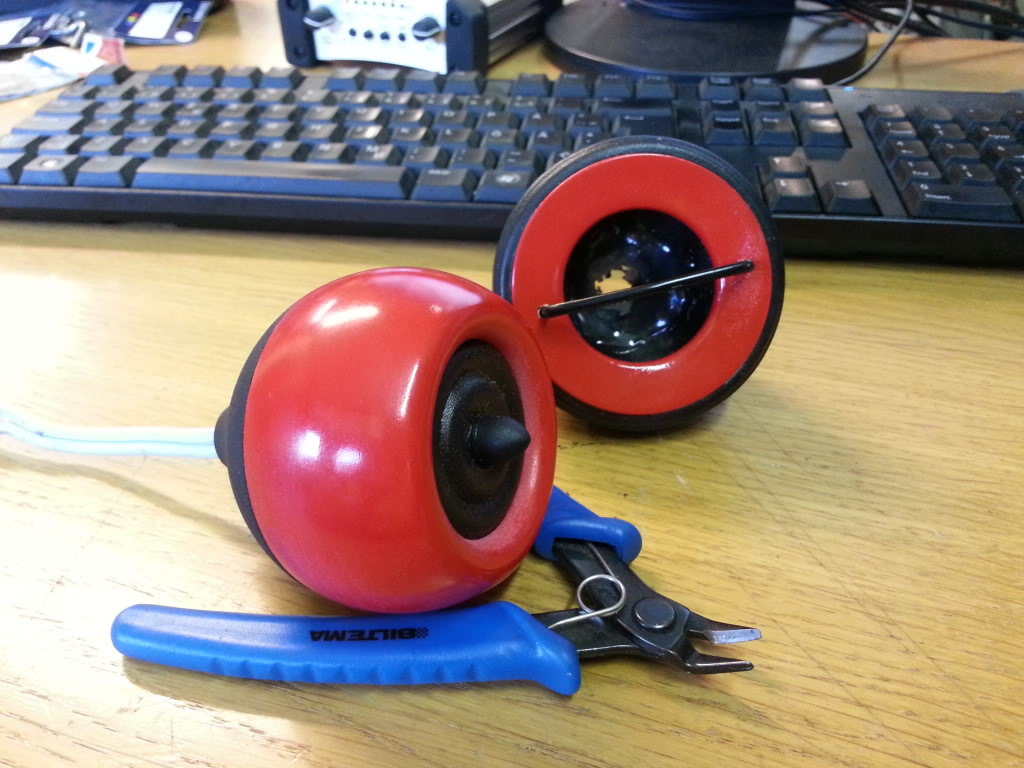
The tweeter is the XT25 SC90, with the original faceplate removed it can be inserted into the pods.
He measured them with the original faceplate (as seen in the picture on the right) and the printed sphere. Here's the result of those measurements.
The inspiration for my door pod was looking at a more expensive Scan Speak ring radiator faceplate and having it "melted" to my door in an angle I desired. It has some wave guide action before bending back. The round-over part is 70mm.

Mounted in my door:

A friend on the DIYMA forum liked what I had done so I ended up designing a (two part) free standing pod for him.

Here's the printed (and painted) result:
The tweeter is the XT25 SC90, with the original faceplate removed it can be inserted into the pods.
He measured them with the original faceplate (as seen in the picture on the right) and the printed sphere. Here's the result of those measurements.
The inspiration for my door pod was looking at a more expensive Scan Speak ring radiator faceplate and having it "melted" to my door in an angle I desired. It has some wave guide action before bending back. The round-over part is 70mm.
Attachments
Last edited:
Here's the printed (and painted) result:

The tweeter is the XT25 SC90, with the original faceplate removed it can be inserted into the pods.
He measured them with the original faceplate (as seen in the picture on the right) and the printed sphere. Here's the result of those measurements.
Thanks Wesayso - once again your knowledge and experience helps me sleep better!
That looks quite similar to the 'bamboo pod' I have made with a similar round over etc. It is even more of a fair comparison as the XT25 is of course the cheaper cousin of the Scanspeak 7000!
His measurements also echo my quick ones too - with an apparent improvement over the 'traditional' cabinet.
Thank you again - I was starting to think of further ways of mounting the tweeter and I already have a garage full of 'pod prototypes'!
I need one of those for my Visaton B80 as the mid hole filler "pod" above my T & W. Nice design there Wesayso. Like the color too. Can you grow one (scale up) for a B80? 😀
I need to fix that filament clogged nozzle on mine.
I need to fix that filament clogged nozzle on mine.
Post arrived just now, the MW19p-4s...
Very nice drivers.
Here's a mock up with the drivers sat in their spheres.
They are looking great!
I did notice this after I posted and I agree that a sealed box with dsp is the way to go. I have used twin Peerless 830452 in this fashion but in a conventional shape box. Finding a suitable woofer is always the key.Just noticed this in your post - perhaps you haven't had a chance to read the thread right through - but this is exactly what I am planning with a schedule 80 12" PVC pipe and four subwoofers.
The 'bass sphere' will only reach down to 80-90 Hz, so I am planning two stereo push-push force cancellation sub-woofers exactly as you propose. 😀😀😀
I have no experience of the IKEA bamboo bowls but a word of caution. I once considered using block jointed end-grain cutting board material for a turntable plinth. I even bought the large cutting boards which sat on a shelf in my workshop for at least a year. When I finally pulled them down to use, I found the glue joints had parted and even the end-grain split in numerous places. They ended up in the bin. You might investigate the durability of the jointed bamboo due to drying out. I know from experience that the strand woven bamboo floorboard material is very durable but hard on cutting blades, but I suspect that the IKEA spheres are quite different, principally because they are food grade products and cannot risk using toxic glues or resins. It would be a shame if your bamboo bowls started to come apart down the track, especially since they will be subject to constant vibration. I hope you don't consider I'm being negative for it's own sake. Just pointing out some pitfalls (you might have already spotted).😀
- Status
- Not open for further replies.
- Home
- Loudspeakers
- Multi-Way
- Great Balls of Prestige
